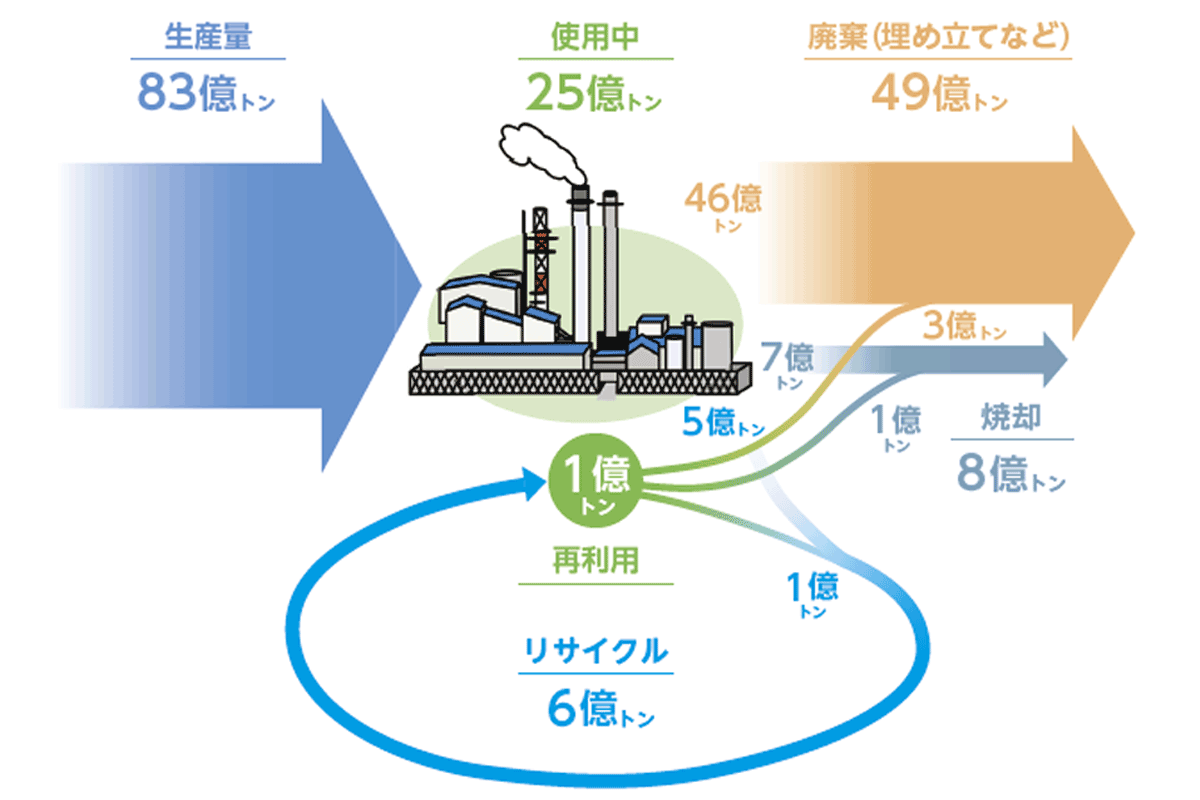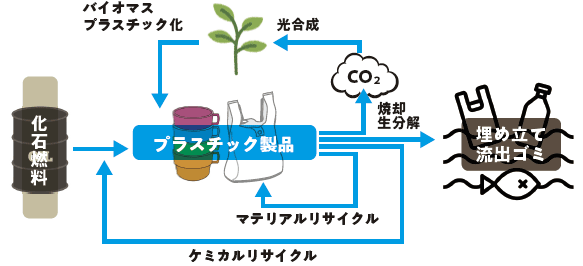- Information for Middle and High School Researchers
Rethinking the Relationship between Humans and Plastics
2020.10.08
In recent years, the idea that the use of disposable plastics has a negative impact on the environment has developed into a social phenomenon, giving rise to movements such as the introduction of a charge for plastic bags and the elimination of plastic straws. On the other hand, in Europe and the United States, where the new coronavirus is spreading, the use of disposable plastic bags has begun to be recommended again to prevent infection.
It has been more than 100 years since the first industrial production of plastic (phenolic resin) took place in the early 1900's. Production has increased from 2 million tons in 1950 to 381 million tons in 2015, roughly 190 times that amount, and is used as a raw material for familiar products such as packaging materials and toys, as well as for the interiors of automobiles, houses and other It has been used as a raw material for familiar products such as packaging and toys, as well as for the interiors of large structures such as cars and houses.
They are lightweight, durable, inexpensive, and hygienic when disposed of. How can we create a sustainable society while striking a balance between such benefits and inconveniences such as environmental impact? In order to think about this, it is necessary not only to look at one easy-to-understand aspect, but also to continue to discuss the ideal society while learning related knowledge.
How to achieve a sustainable carbon cycle?
Is plastic an "issue"?
It is estimated that 8.3 billion tons of plastic was produced from 1950 to 2015. Of this, 2.6 billion tons, including recycled products, are still in use in some form, 800 million tons are incinerated, and a whopping 4.9 billion tons are landfilled or released into the environment (Figure 1). Most of what is produced is made from petroleum, an exhaustible resource. Of the fossil fuels produced by digging fossil fuels out of the ground, 5.7 billion tons are already unused in society, becoming CO2 and garbage.
And now this unrecycled waste is becoming a major problem. It is estimated that 150 million tons are already floating in the ocean, with an additional 8 million tons being released every year. Some of it is broken into small pieces of microplastics (less than 5 mm in diameter), which are beginning to accumulate in the bodies of fish and shellfish that ingest them. In addition, fishing nets and plastic bags drift through the ocean, becoming entangled in sea turtles and other marine life, or swallowed by whales.
Should plastic products be eradicated to solve these problems? The answer would be no. Plastic products are used everywhere in society, from smartphone lenses and chairs to air conditioner housings and airplane interiors. They are lightweight, durable, and come in a variety of colors. It is impossible to replace all of these materials with other materials, which, with the addition of additives, can be made flame retardant and inexpensive. That is why we are now in a situation where we need to envision a sustainable plastic-using society that is not based on the conventional linear production-consumption-disposal system.

Figure 1: Amount of plastic produced, used, and disposed of worldwide from 1950-2015
(Naoki Hosaka, Marine Plastic: The Eternal Waste of KADOKAWA, Inc. 2020)
Capturing the Carbon Stream
When drawing a sustainable shape, it is necessary to consider the carbon (C) cycle. Let's draw the flow of carbon with a focus on plastics (Figure 2). Carbon, which was previously buried underground as fossil fuel, is excavated, refined, and converted into plastic products. Part of the carbon is then melted down and remolded as material, or broken down into smaller molecules before being reused in chemical recycling, and then returned to the product. However, in order to be sent to these processes, products made from specific raw materials must be free of admixtures, and the conditions are strict and energy-intensive. As a result, many are incinerated and turned into carbon dioxide (CO2), which is either released into the atmosphere, landfilled, or spilled, leaving behind plastic chunks and pieces. Biodegradable plastics, which are being promoted for use, also become CO2 after decomposition by microorganisms.
Until now, the amount of plastic products needed by society was not sufficient to provide the amount of plastic products needed by society without using fossil fuels as a material. This is one of the challenges. By increasing the amount of biomass plastics made from plants that grow by absorbing CO2 from the atmosphere, we can fatten the circulating arrows and reduce our dependence on fossil fuels. Also, an increase in biodegradable materials would accelerate this trend while reducing the amount of waste. Furthermore, if the amount of recycling can be increased through social mechanisms and changes in consumer behavior, this should also lead to a thickening of the circulation.
 Figure 2: Carbon Movement Considered with a Focus on Plastics
Figure 2: Carbon Movement Considered with a Focus on Plastics
Can we move closer to an ideal recycling society?
Let us envision an ideal situation from the perspective of the carbon cycle. All necessary materials are made from plant-derived raw materials. They are molded into products and used in society for a certain period of time. When they are finished, they are sorted by product form or material and sent for recycling as appropriate. Items used in agriculture and fisheries are cleanly biodegraded and turned into CO2. Those that are contaminated and cannot be recycled are incinerated and turned into CO2, which is then used to make plants again. From there, raw materials are made again...
This society in which carbon goes round and round in a big cycle seems to be a far cry from the linear society of today. But what can we do to move closer to the ideal? In the following pages, we will introduce the perspectives of experts in academia who are currently tackling this issue.
*Reprinted from "Education Support vol. 47
